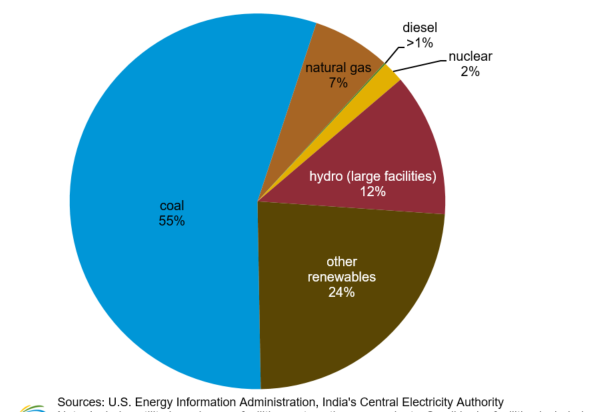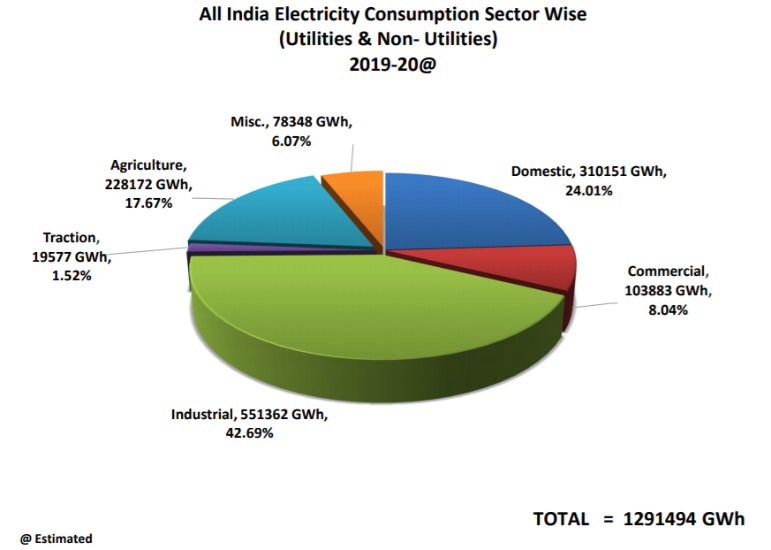In 21st century electricity has become one of the basic needs of human beings. Electricity which reaches our homes and offices, factories and agricultural fields has passed through three main distinct stages: Generation, Transmission and Distribution.
India is the third largest consumer of electricity in the world with annual consumption of more than 1.3 lakh crore units. However quite a large chunk of our population is still deprived of electricity. Besides this, a large number of families try to reduce their consumption to a bare minimum because they cannot afford more. That is why the per capita consumption in the country is only one-third of the global average.
The installed capacity in India has grown from 1700 MW to 3,77,000 MW over the last seventy years. The focus of the Government now is on renewable energy.
India’s installed power capacity by fuel, June 2020
Electricity generation, transmission and distribution together constitute one of the largest single businesses in our country, with an annual revenue of more than Rs. 7 lakh crore.
Industrial and commercial establishments account for half of the electricity consumption in the country.
The power sector is in the “concurrent list of subjects”. This means that both the Central and respective State governments are interested in the subject and hence have power to make laws.
Before independence a law passed in 1910 governed the power sector. There were hundreds of private electricity companies across the country but they supplied power only to a limited number of profitable consumers from cities.
Immediately after independence the Electricity Act 1948 was enacted. It was declared that electric power is the backbone of the country and hence it is the responsibility of the government to ensure supply of power in every nook and corner of our country at affordable rates. It was also declared that profit should not be the motive of the power sector. State Electricity Boards were created in each state to generate and supply electricity.
Bulk of the electricity requirement of the country was supplied by the public sector (state + central sectors) enterprises for the first fifty years after independence; the share of the private sector was less than 10 % till 2000. The share of the private sector grew slowly for the next ten years to around 20% and grew very rapidly after 2010. Nearly half (47%) of the generating capacity is already in the private sector by 2020. Most of the new capacity is coming up in the private sector.
Privatisation of the Electricity Sector
From the decade of 1980 the Central and state governments started throttling power generation systematically by stopping any fresh government investments in it. As a result of that, power shortage was artificially created leading to frequent power outages across the country. This was a conspiracy by governments with an objective of creating public support for opening up the power sector for private investment. Governments started talking of opening up the private sector for foreign investment.
These steps gained tremendous momentum with the announcement of the New Economic Policy of Globalization through Liberalization and Privatization (LPG) announced by the Narsimha Rao led Congress government at the centre in 1991-92. All parties which have shared power at the centre since then have assiduously implemented the same policy, thus leading to increased privatization of the public sector including the electricity sector.
Tremendous damage to public interest due to private sector entry in power generation is well exemplified by the experience of Enron. The American company, Enron was invited in 1992 with open arms to set up power generation facility in Dabhol, Maharashtra in spite of tremendous opposition from electricity workers and the people at large. The then Maharashtra State Electricity Board (MSEB) was forced to buy electricity from Enron at a very high price due to which more than Rs. 3361 crores extra was spent by it. After this exposure and due to increased opposition from workers of MSEB and people of Maharashtra, the agreement with Enron had to be cancelled on 23rd May 2001.
In Delhi in 2002 Tatas and Reliance of Anil Ambani took over power supply and distribution.
The Vajpyee led BJP government passed the Electricity Act 2003 despite severe opposition by workers. It mandated corporatization of the power sector and its break-up into three parts – generation, transmission and distribution so that the profitable parts, generation and distribution could be privatised.
The privatisation of the power generation sector proceeded rapidly. Big capitalist groups like Tata, Anil Ambani, Jindal, Torrent group, GVK, Jaypee, Hindujas, etc. aggressively entered the field. Various state power distribution companies (DISCOMS) were forced to purchase electricity from them at much higher rates. For example, though the current solar energy cost is Rs 2.44 per unit, DISCOMS are forced to pay much higher rates of Rs.15/- per unit in Gujarat and Rs. 4.60 per unit in Andhra Pradesh as per the old power purchase agreements (PPA)! State DISCOMS are not allowed to renegotiate these agreements.
Different approaches were tried to privatise distribution. In many states and cities, privatisation of distribution failed because capitalists did not find it attractive and state DISCOMS had to take it back, leading to loss of hundreds of crores of rupees of public money.
From 2014 onwards, the government is trying to amend the Electricity Act 2003. It failed repeatedly in 2017 and 2018 due to the united opposition from workers all over the country.
The draft Electricity (Amendment) Bill 2020 had proposed elimination of all subsidies on the supply of electricity. This was strongly opposed by farmers and was one of the demands of the ongoing farmers’ agitation since November 2020.
The Electricity (Amendment) Bill 2021 is aimed at the complete privatisation of electricity distribution all over the country. State governments will have no say in the matter. It proposes the following:
(i) Electricity distribution will be delicensed. The present Distribution Companies will continue to operate as they are now, but other Distribution Companies can also come in and compete. Consumers shall have the opportunity to select their electricity supplier.
(ii) The DISCOM shall allow use of its existing infrastructure to private companies to supply electricity and will not discriminate against private companies even though they would be competing with the DISCOM. It also means that private companies will not have to invest any money to create distribution infrastructure and get to use the infrastructure already created with public money to earn tremendous profits.
These and other provisions of the Bill will ultimately lead to the DISCOMS being driven out of business and to private monopoly over power distribution.






